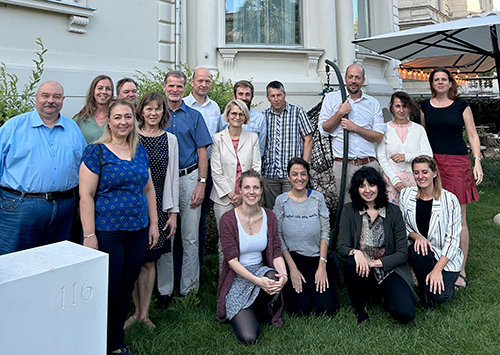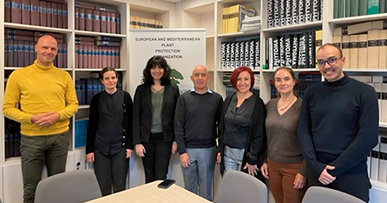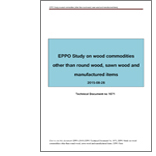
EPPO activities on Pest Risk Analysis
Pest Risk Analysis (PRA)
Pest Risk Analysis: The process of evaluating biological or other scientific and economic evidence to determine whether an organism is a pest, whether it should be regulated, and the strength of any phytosanitary measures to be taken against it (ISPM 5, FAO).
In order to prevent the entry and spread of damaging pests, it is important to identify potential risks at an early stage and propose technically justified phytosanitary measures to mitigate these risks. In order to formalize this process, the concept of PRA has been developed and used, both at global and regional level. The aim of PRAs is to decide whether pests should be regulated or not as quarantine pest and propose risk management options. Since the 1990s, EPPO has been developing Standards on how to perform PRAs. These Standards remain in line with what has also been developed within the IPPC framework, in particular with ISPM 11 – Pest Risk Analysis.
For more information on PRA, read the EPPO Technical Document; Review of EPPO’s approach to Pest Risk Analysis (no. 1079, 2019)
How PRAs are conducted within EPPO
A Panel on Phytosanitary Regulations was established in 1973. It was renamed Panel on Phytosanitary Measures in 2002. Its aim is at advising on addition or deletions of pests to the EPPO Alert List, recommend pests for regulation and their management options, based on review of PRAs. The Panel meets twice a year. Its current composition and summaries of its meeting discussions can be viewed on this website.

Panel on Phytosanitary Measures, Budapest (HU) 2023-10-3/5
The general methodology for conducting PRAs has been elaborated by the EPPO Panel on PRA development. Since 2006, EPPO organizes meetings of Experts Working Groups (EWGs) which are conducting PRAs on specific pests or groups of pests. PRAs are reviewed by the relevant Panels (Panel on Phytosanitary Measures and Panel on Invasive Alien Plants) and endorsed by the Working Party on Phytosanitary Regulations. EPPO conducts PRAs and makes recommendations for the EPPO region.

EWG on Chloridea virescens (Paris, FR, 2023-11-13/16)

EWG on Agrilus mali (Paris, FR, 2023-05-30 to 06-02)
EPPO Standards on PRA
The following EPPO Standards on PRA have been agreed and published. All can be retrieved from this website in our section on Standards. Files are also stored in the EPPO Global Database ![]()
- PM 5/1(1) Check-list of information required for PRA
- PM 5/2(2) PRA on detection of a pest in an imported consignment
- PM 5/3(5) Decision-support scheme for quarantine pests (version 2011)
- PM 5/5(1) Decision-Support Scheme for an Express Pest Risk Analysis (and guidance document)
- PM5/6(1) EPPO prioritization process for invasive alien plants
- PM5/7(1) Screening process to identify priorities for commodity PRA for plants for planting
- PM5/8(1) Guidelines on the phytosanitary measure ‘Plants grown under physical isolation’
- PM 5/9(1) Preparation of pest lists in the framework of commodity PRAs
-
PM 5/10(1) Guidelines on the design and implementation of a buffer zone
EPPO Platform on PRAs
The EPPO Platform on PRAs contains:
- EPPO PRAs
- EFSA PRAs
- National PRAs prepared by EPPO member countries
- PRAs produced in the framework of EU-funded projects
- A selection of interesting PRAs from other parts of the world
- Scientific articles related to PRA activities
![]()
The EPPO Platform on PRAs contains a large number of PRAs produced since the early 1990s to the present date, as well as some additional documents related to PRA activities. In a restricted part of the Platform, registered users can also share draft PRAs, or their future plans to conduct PRAs in order to facilitate collaboration and share the workload.
PRAs prepared by dedicated EPPO Expert Working Groups
All PRAs that have been prepared with EPPO Expert Working Groups since 2006 are listed below. To access PRA documents and datasheets (stored in EPPO Global Database) click on the links.
| Gastropoda | |
| Pomacea canaliculata | A1 - 2018 |
| Pomacea maculata | A2 - 2018 |
| Nematodes | |
| Bursaphelenchus xylophilus | A1 - transferred to A2 in 2010 |
| Meloidogyne enterolobii | A2 - 2010 |
| Meloidogyne mali | A2 - 2017 |
| Fungi (and fungus-like) | |
|
Ceratocystis ficicola – New |
A2 - 2025 |
| Fusarium oxysporum f. sp. cubense Tropical race 4 | A2 – 2024 |
| Geosmithia morbida and Pityophthorus juglandis | A2 - 2015 |
| Heterobasidion irregulare | A2 - 2015 |
| Phytophthora kernoviae and Phytophthora ramorum | A2 - 2013 |
| Phytophthora lateralis | A1 - transferred to A2 in 2011 |
| Thekopsora minima | A2 - 2017 |
| Bacterium | |
| Candidatus Phytoplasma phoenicium | A1 - 2017 |
| Candidatus Liberibacter solanacearum | A1 - 2012 |
| Pseudomonas syringae pv. actinidiae | A2 - 2012 |
| Xanthomonas axonopodis pv. allii | A1 - 2009 |
| Viruses | |
| Citrus bark cracking viroid | A2 - 2017 |
| Grapevine red blotch virus | A1 – 2022 |
| Not added | |
| Rose rosette emaravirus and its vector Phyllocoptes fructiphilus | A1 - 2018 |
| Tomato brown rugose fruit virus | A2 – 2020 |
| Tomato leaf curl New Delhi virus | A2 – 2022 |
| Tomato mottle mosaic virus | Not added |
PRAs under development or planned in the near future
PRAs being prepared by Expert Working Groups (EWGs) or under review within EPPO are listed in the EPPO Platform on PRAs ![]()
Special projects and EPPO studies
 EPPO has carried out several studies on the risks associated with different commodities. These have been published as EPPO Technical Documents.
EPPO has carried out several studies on the risks associated with different commodities. These have been published as EPPO Technical Documents.
- EPPO Study on the risk of bark and ambrosia beetles associated with imported non-coniferous wood (no. 1081, 2020)
- EPPO Secretariat’s approach for commodity studies (no. 1074, 2016)
- EPPO Study on wood commodities other than round wood, sawn wood and manufactured items (no. 1071, 2015)
- EPPO Study on pest risks associated with the import of tomato fruit (no. 1068, 2015)
- EPPO Study on the risk of imports of plants for planting (no. 1061, 2012)
EPPO has participated in several EU-funded projects related to PRA (e.g. PRATIQUE, DROPSA, LIFE IAP project).
Conferences and Workshops on PRA
EPPO has organized a series of workshops and conferences on PRAs. The most recent ones are listed below.
-
EPPO Training course on PRA for invasive alien plants (Belgrade, 2018-11-29/30)
- Workshop on regulated pests: risk analysis and listing (Moscow, 2018-06-06/08)
-
EPPO Training workshop 2: EPPO Express PRA for invasive alien plant species compliant with the Regulation (EU) No. 1143/2014 (Paris, 2017-02-14/17)
- Joint EFSA-EPPO Workshop: Modelling in Plant Health – how can models support risk assessment of plant pests and decision making? (Parma, IT, 2016-12-12/14)
-
EPPO Training workshop 1: EPPO Prioritization Process for invasive alien plant species compliant with EU Regulation No 1143/2014 (Paris 2016-12-14/17)
- FAO/EPPO Workshop on 'Commodity-associated phytosanitary risk, its analysis and management' (Bishkek, KG, 2014-06-03/06)
- EPPO Training course on the EPPO prioritization process for invasive alien plants (Belgrade, 2013-07-09/11)
- EPPO Training course on the EPPO prioritization process for invasive alien plants (Paris, 2013-03-12/14)
- PRATIQUE / EPPO Workshop on Pest Risk Analysis (Hammamet, TN, 2010-11-23/26)
- Atelier de formation de base sur l’Analyse du Risque Phytosanitaire (Hammamet, Tunisie, 2010-02-09/12)
Summaries of the recent conferences and workshops can be viewed on this website
Useful references
Articles published in the EPPO Bulletin
- Baker RHA (2012) An introduction to the PRATIQUE Research Project. EPPO Bulletin 42(1), 1-2.
- Griessinger D, Suffert M, Brunel S, Petter F (2012) CAPRA: the EPPO Computer Assisted PRA scheme. EPPO Bulletin 42(1), 42-47.
Websites
- ANSES (French Agency for Food, Environmental and Occupational Health & Safety)
- International Pest Risk Research Group (IPRRG)
- IPPC (ISPMs on PRA)
- Julius Kühn-Institut (JKI) – Risikoanalysen
- Netherlands Food and Consumer Product Safety Authority – Pest Risk Analysis
- Norwegian Scientific Committee for Food and Environment – Risk assessments
- Polish Research Centre of Quarantine, Invasive and Genetically Modified Organisms
- Swedish University of Agricultural Sciences
- UK Plant Health Information Portal – Pest risk analyses
